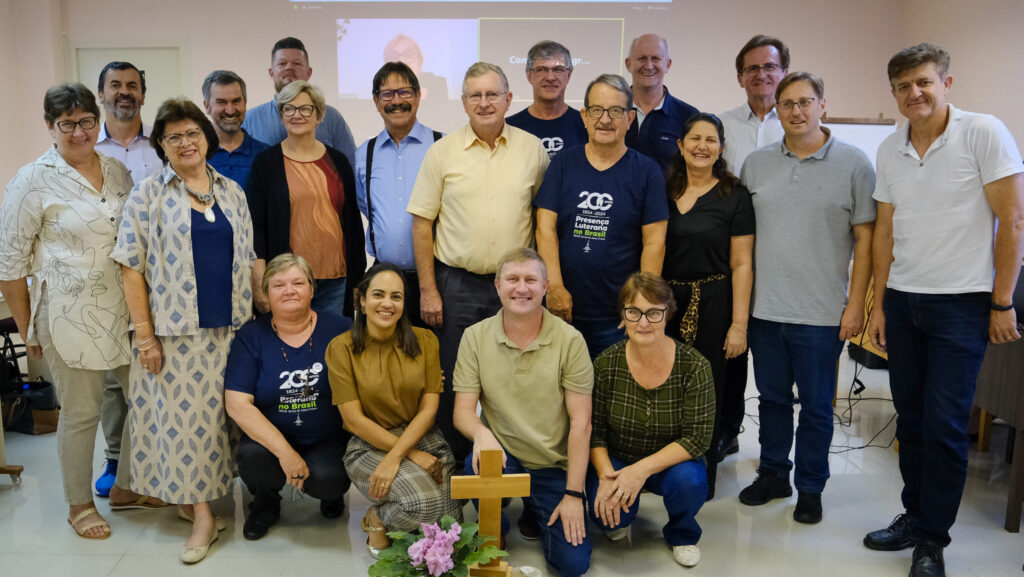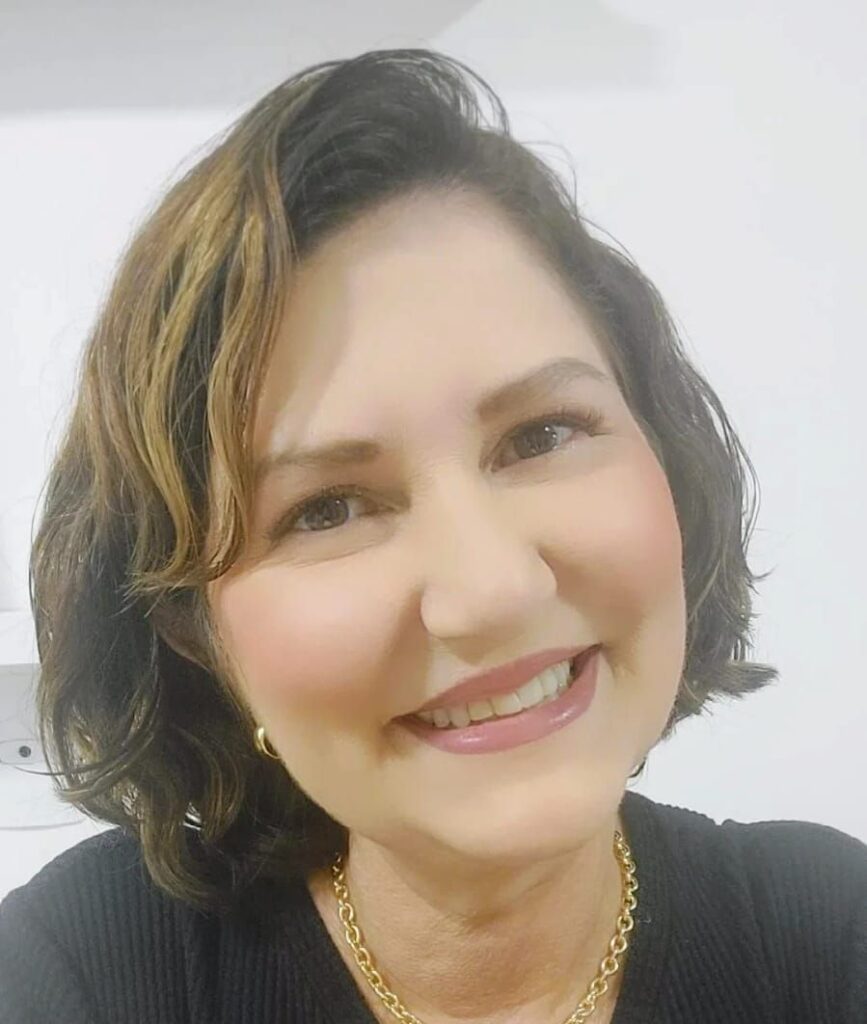Clique em “Ver mais” para ter a visão geral ou acesse diretamente os conteúdos através dos links abaixo.
Ver maisConheça as ênfases e atividades realizadas na Igreja Evangélica de Confissão Luterana no Brasil (IECLB).
Ver maisTenha acesso a conteúdos por temas e âmbitos de trabalho da Igreja Evangélica de Confissão Luterana no Brasil (IECLB).
Ver maisAcesse serviços e documentos da Igreja Evangélica de Confissão Luterana no Brasil (IECLB).
Ver maisConfira os eventos e os cursos oferecidos pela Igreja Evangélica de Confissão Luterana no Brasil (IECLB).
Ver maisFortaleça a fé com as Senhas Diárias, as Meditações Diárias e o Culto Nacional Online.
Ver maisFique por dentro do que acontece na Igreja Evangélica de Confissão Luterana no Brasil (IECLB).
Ver mais
Um terço das pessoas integrantes é composta por Ministras ou Ministros e dois terços por lideranças que não fazem parte do Ministério com Ordenação.
O Conselho da Igreja tem uma Diretoria com Presidente, Vice-Presidente, 1º Secretário ou 1º Secretária e 2º Secretário ou 2º Secretária. O mandato da diretoria é de dois anos, permitida uma reeleição.
O Pastor ou a Pastora Presidente, os Pastores ou Pastoras Vice-Presidentes e o Secretário-Geral ou Secretária-Geral têm assento nas reuniões com direito a voz, porém sem direito a voto. Da mesma forma, o Presidente ou a Presidente do Concílio da Igreja participa das reuniões do Conselho da Igreja, com direito a voz, mas sem direito a voto.

Presidente
Adelino Sasse
Representante do Sínodo
Vale do Itajaí

Vice-Presidente
Astrid Golke Balz
Representante do Sínodo
Noroeste Riograndense

Secretário
P. Enos Heidemann
Representante do Sínodo
Rio dos Sinos

Vice-Secretária
Débora Eriléia Pedrotti
Representante do Sínodo
Mato Grosso
Representante titular: Ricardo Dalla Barba
Representante suplente: Ema Marta Dunck Cintra
Representante titular: Elfi Roedel
Representante suplente: Clarisse May
Representante titular: Pastor Israel Wolney Sell
Representante suplente: Pastor Joelson Erbert Martins
Representante titular: Rudibert Rueckert
Representante suplente: Rosangela Dobke Waiandt
Representante titular: Lara Gomes Reis Costa
Representante suplente: Welton Kruger
Representante titular: Débora Eriléia Pedrotti
Representante suplente: Leonel da Conceição Gomes Pinto
Representante titular: Pastor Jorge Rucks Hirt
Representante suplente: Pastor Jeferson Rusch
Representante titular: Astrid Gohlke Balz
Representante suplente 1: Liria Hanel Seiboth
Representante suplente 2: Rosmeri Gerhardt Pooder
Representante titular: Marcio Marcos Manke
Representante suplente 1: Carlos Henrique Sacht
Representante suplente 2: Marilze Wischral Rodrigues
Representante titular: Carlos Magno Andrioli Bittencourt
Representante suplente 1: Elizabeth Flemming
Representante suplente 2: Gudrun Piper Schmidt
Representante titular: Liani Plegge
Representante suplente 1: Silvino Bernardo Lamb
Representante suplente 2: Lauri Diefenthäler
Representante titular: Pastor Enos Heidemann
Representante suplente 1: Pastora Scheila dos Santos Dreher
Representante suplente 2: Pastor Mateus Holz Tasso
Representante titular: Pastor Vernei Hengen
Representante suplente 1: Pastora Sandra Kamien Tehzy
Representante suplente 2: Pastor Marlon Jonas Radons
Representante titular: Pastor Ernani Röpke
Representante suplente: Pastora Daiane Berndt Bottcher
Representante titular: Diaconisa Isolete Marcia Follmer
Representante suplente: Diaconisa Lovani Lilge
Representante titular: Romeo Weirich
Representante suplente 1: Cleci Terezinha Koch
Representante suplente 2: Dirce Semin Zang
Representante titular: Adelino Sasse
Representante suplente 1: Roberto Boebel
Representante suplente 2: Cristian Fuchs
Representante titular: Carlos Gressler
Representante suplente 1: Gládis Kettermann Dickel
Representante suplente 2: Wilson Henn
Portal Luterano
We firmly believe that the internet should be available and accessible to anyone, and are committed to providing a website that is accessible to the widest possible audience, regardless of circumstance and ability.
To fulfill this, we aim to adhere as strictly as possible to the World Wide Web Consortium’s (W3C) Web Content Accessibility Guidelines 2.1 (WCAG 2.1) at the AA level. These guidelines explain how to make web content accessible to people with a wide array of disabilities. Complying with those guidelines helps us ensure that the website is accessible to all people: blind people, people with motor impairments, visual impairment, cognitive disabilities, and more.
This website utilizes various technologies that are meant to make it as accessible as possible at all times. We utilize an accessibility interface that allows persons with specific disabilities to adjust the website’s UI (user interface) and design it to their personal needs.
Additionally, the website utilizes an AI-based application that runs in the background and optimizes its accessibility level constantly. This application remediates the website’s HTML, adapts Its functionality and behavior for screen-readers used by the blind users, and for keyboard functions used by individuals with motor impairments.
If you’ve found a malfunction or have ideas for improvement, we’ll be happy to hear from you. You can reach out to the website’s operators by using the following email
Our website implements the ARIA attributes (Accessible Rich Internet Applications) technique, alongside various different behavioral changes, to ensure blind users visiting with screen-readers are able to read, comprehend, and enjoy the website’s functions. As soon as a user with a screen-reader enters your site, they immediately receive a prompt to enter the Screen-Reader Profile so they can browse and operate your site effectively. Here’s how our website covers some of the most important screen-reader requirements, alongside console screenshots of code examples:
Screen-reader optimization: we run a background process that learns the website’s components from top to bottom, to ensure ongoing compliance even when updating the website. In this process, we provide screen-readers with meaningful data using the ARIA set of attributes. For example, we provide accurate form labels; descriptions for actionable icons (social media icons, search icons, cart icons, etc.); validation guidance for form inputs; element roles such as buttons, menus, modal dialogues (popups), and others. Additionally, the background process scans all the website’s images and provides an accurate and meaningful image-object-recognition-based description as an ALT (alternate text) tag for images that are not described. It will also extract texts that are embedded within the image, using an OCR (optical character recognition) technology. To turn on screen-reader adjustments at any time, users need only to press the Alt+1 keyboard combination. Screen-reader users also get automatic announcements to turn the Screen-reader mode on as soon as they enter the website.
These adjustments are compatible with all popular screen readers, including JAWS and NVDA.
Keyboard navigation optimization: The background process also adjusts the website’s HTML, and adds various behaviors using JavaScript code to make the website operable by the keyboard. This includes the ability to navigate the website using the Tab and Shift+Tab keys, operate dropdowns with the arrow keys, close them with Esc, trigger buttons and links using the Enter key, navigate between radio and checkbox elements using the arrow keys, and fill them in with the Spacebar or Enter key.Additionally, keyboard users will find quick-navigation and content-skip menus, available at any time by clicking Alt+1, or as the first elements of the site while navigating with the keyboard. The background process also handles triggered popups by moving the keyboard focus towards them as soon as they appear, and not allow the focus drift outside it.
Users can also use shortcuts such as “M” (menus), “H” (headings), “F” (forms), “B” (buttons), and “G” (graphics) to jump to specific elements.
We aim to support the widest array of browsers and assistive technologies as possible, so our users can choose the best fitting tools for them, with as few limitations as possible. Therefore, we have worked very hard to be able to support all major systems that comprise over 95% of the user market share including Google Chrome, Mozilla Firefox, Apple Safari, Opera and Microsoft Edge, JAWS and NVDA (screen readers).
Despite our very best efforts to allow anybody to adjust the website to their needs. There may still be pages or sections that are not fully accessible, are in the process of becoming accessible, or are lacking an adequate technological solution to make them accessible. Still, we are continually improving our accessibility, adding, updating and improving its options and features, and developing and adopting new technologies. All this is meant to reach the optimal level of accessibility, following technological advancements. For any assistance, please reach out to

